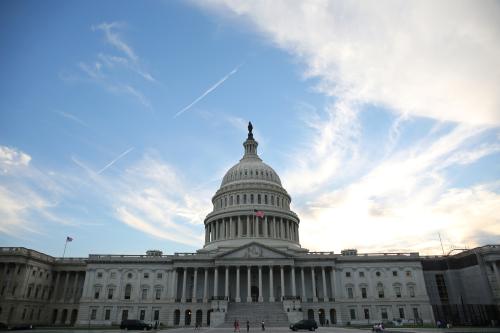On a sultry hot day in the middle of summer, a standing room-only crowd gathered here in Washington to hear Molly E. Reynolds discuss her new book, Exceptions to the Rule: The Politics of Filibuster Limitations in the U.S. Senate. The topic of the book—Senate procedures adopted to reduce the hurdles a bill must pass before it becomes law—has always been of interest to political scientists and historians of Congress. But in these days of “tribal politics,” previously obscure procedural issues have taken on new importance—especially the budget procedure known as reconciliation.
And Reynolds’ book explains why.
The reconciliation process was created in 1974 as part of the overall budget reforms enacted that year. A reconciliation bill can by triggered by a budget resolution that contains instructions to specific congressional committees that tell them to develop proposals to change certain types of programs they oversee. Unlike most other legislation, reconciliation bills cannot be filibustered. For the budgetary policy priorities that are eligible to be handled through the reconciliation process, this leaves the majority party with a decision about the best way to get to what they want. Reynolds sums it up as follows: “If the majority party…is better off with the policy that reconciliation can produce, we would expect the majority leader to initiate the process. The leader’s expectations about the different policies that can be achieved, however, are shaped by the preferences of the other actors who are powerful in each instance.”
In today’s tumultuous congressional politics, the decision to use reconciliation is basically an indication that the party in charge wants to go it alone, in part because they know it is unlikely that a filibuster can be overcome on a key piece of legislation. This is what happened in the Senate’s consideration of their seven year-old campaign pledge to repeal Obamacare. Senate Republicans chose to use reconciliation, betting that they would get no Democratic votes and that they could hold onto nearly everyone in their caucus and that, if needed, Vice President Pence could break a tie in their favor. In other words, they bet they would lose only two votes—not three. But in the end, they lost three votes, with Senator John McCain making a dramatic comeback from his hospital bed, and the measure died.
So what’s next? As Reynolds teaches us—watch the procedural choices. As Congress turns to tax reform, Majority Leader McConnell has signaled that he will use reconciliation again. This means he expects to be able to muster 50 votes for a Republican-only bill; a conclusion reinforced by a letter from 45 Democratic Senators said they would only cooperate with Republicans if the tax plan did not add to the deficit or cut the annual tax bill of the richest one percent of taxpayers.
Given the drama around the failure to repeal Obamacare, reconciliation is getting a lot of airtime, but Reynolds’s book discusses other “exceptions to the rule” that are also central to the current political drama in Washington. Congress has also been known to pass legislation that gives it a say in how a president is implementing the law in order to, as Reynolds writes, “increase Congress’s ability to oversee the actions of the executive.”
This week Congress sent a bill to the President increasing the already stern sanctions on Russia. In it they included a provision that would allow congressional review of the president’s attempt to ease sanctions, including some special procedures smoothing the path of a legislative response to the president’s decision. The White House objected to this provision in a signing statement, calling it an unconstitutional restriction of the President’s powers to negotiate with foreign powers.
But the bill passed both houses of Congress by overwhelming numbers, making it unwise for the president to veto (as Congress had more than enough votes to override), and so he signed the bill.
This humiliation was overshadowed by the health care drama, but it is, perhaps, more significant for President Trump in the long run. The promise to repeal Obamacare started in 2010 and pre-dated Trump’s presidential campaign. While failure to repeal is probably more of a Republican Congressional failure than a Trump failure, Russia is 100 percent a Trump problem. By including restrictions on the president’s actions in the sanctions bill, both Democrats and Republicans have indicated that, when it comes to Russia, they do not trust the President—and that could have ramifications as the many investigations of his campaign unfold.










Commentary
Reconciliation isn’t the only rule to watch in Congress
August 4, 2017